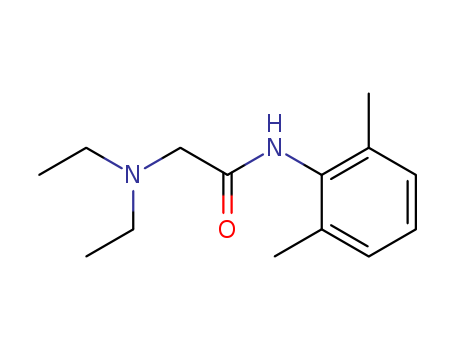- +86 15383000851
- +86 15303238802
- admin@hebeianda.cn


pd_meltingpoint:66-69 °C
Appearance:solid
Purity:99%
High Purity Good Producer Lidocaine 137-58-6 99% Pur We provide high quality Lidocaine (CAS 137-58-6), at a very affordable prices to our customers.
Lidocaine [2-(diethylamino)-N-(2, 6-dimethylphenyl) acetamide monohydrochloride] is the most commonly used amino amide-type local anesthetic. Lidocaine is very lipid soluble and, thus, has a more rapid onset and a longer duration of action than most amino ester-type local anesthetics, such as procaine and tetracaine. It can be administered parenterally (with or without epinephrine) or topically either by itself or in combination with prilocaine or etidocaine as a eutectic mixture that is very popular with pediatric patients. The use of lidocaine–epinephrine mixtures should be avoided, however, in areas with limited vascular supply to prevent tissue necrosis. Lidocaine also frequently is used as a class IB antiarrhythmic agent for the treatment of ventricular arrhythmias, both because it binds and inhibits sodium channels in the cardiac muscle and because of its longer duration of action than amino ester-type local anesthetics. Central nervous system changes are the most frequently observed systemic toxicities of lidocaine. The initial manifestations are restlessness, vertigo, tinnitus, slurred speech, and eventually, seizures. Subsequent manifestations include CNS depression with a cessation of convulsions and the onset of unconsciousness and respiratory depression or cardiac arrest. This biphasic effect occurs because local anesthetics initially block the inhibitory GABAergic pathways, resulting in stimulation, and eventually block both inhibitory and excitatory pathways (i.e., block the sodium channels associated with the NMDA receptors, resulting in overall CNS inhibition).
Experimentally, lidocaine has been found to prevent VF arising during myocardial ischemia or infarction by preventing the fragmentation of organized largewavefronts into heterogeneous wavelets. Although lidocaine is of proven benefit in preventing VF early after clinical myocardial infarction, there is no evidence that it reduces mortality. To the contrary, lidocaine may increase mortality after myocardial infarction by approximately 40% to 60%.There are no controlled studies of lidocaine in secondary prevention of recurrence of VT or VF. Lidocaine terminates organized monomorphic spontaneous VT or induced sustained VT in only approximately 20% of cases and is less effective than many other antiarrhythmic drugs. In a blinded, randomized study of intravenous lidocaine versus intravenous amiodarone in out-of-hospital VF resistant to defibrillation, lidocaine was associated with half the likelihood of survival to hospital admission compared with amiodarone.
Antiarrhythmic Agents, Anesthetics;Anticonvulsant;antihypertensive
The CAS number of Lidocaine is 137-58-6.
More information of Lidocaine 137-58-6 are:
|
CAS Number |
137-58-6 |
|
Density |
1.026 g/cm3 |
|
Melting Point |
66-69 °C |
|
Boiling Point |
350.8 °C at 760 mmHg |
|
Flash Point |
166 °C |
|
Vapor Pressure |
4.28E-05mmHg at 25°C |
|
Refractive Index |
1.5110 (estimate) |
|
HS CODE |
DERIVATION |
|
PSA |
32.34000 |
|
LogP |
2.65670 |
|
Pka |
pKa 7.88(H2O)(Approximate) |
The chemical formula of Lidocaine is C14H22N2O which containing 14 Carbon atoms,22 Hydrogen atoms,2 Nitrogen atoms and 1 Oxygen atoms,and the molecular weight, and the molecular weight of Lidocaine is 234.341
Lidocaine [2-(diethylamino)-N-(2, 6-dimethylphenyl) acetamide monohydrochloride] is the most commonly used amino amide-type local anesthetic. Lidocaine is very lipid soluble and, thus, has a more rapid onset and a longer duration of action than most amino ester-type local anesthetics, such as procaine and tetracaine. It can be administered parenterally (with or without epinephrine) or topically either by itself or in combination with prilocaine or etidocaine as a eutectic mixture that is very popular with pediatric patients. The use of lidocaine–epinephrine mixtures should be avoided, however, in areas with limited vascular supply to prevent tissue necrosis. Lidocaine also frequently is used as a class IB antiarrhythmic agent for the treatment of ventricular arrhythmias, both because it binds and inhibits sodium channels in the cardiac muscle and because of its longer duration of action than amino ester-type local anesthetics. Central nervous system changes are the most frequently observed systemic toxicities of lidocaine. The initial manifestations are restlessness, vertigo, tinnitus, slurred speech, and eventually, seizures. Subsequent manifestations include CNS depression with a cessation of convulsions and the onset of unconsciousness and respiratory depression or cardiac arrest. This biphasic effect occurs because local anesthetics initially block the inhibitory GABAergic pathways, resulting in stimulation, and eventually block both inhibitory and excitatory pathways (i.e., block the sodium channels associated with the NMDA receptors, resulting in overall CNS inhibition).
InChI:InChI=1/C14H22N2O/c1-5-16(6-2)10-13(17)15-14-11(3)8-7-9-12(14)4/h7-9H,5-6,10H2,1-4H3,(H,15,17)/p+1
Relevant articles related to Lidocaine:
|
Article |
Source |
|
1,3,5-Triazinanes as Formaldimine Surrogates in the Ugi Reaction |
Golubev, Pavel,Guranova, Natalia,Krasavin, Mikhail , (2020) |
|
Direct Amidation of Esters by Ball Milling** |
Barreteau, Fabien,Battilocchio, Claudio,Browne, Duncan L.,Godineau, Edouard,Leitch, Jamie A.,Nicholson, William I.,Payne, Riley,Priestley, Ian supporting information, p. 21868 - 21874 (2021/09/02) |
Hebei anda Technology Co., Ltd is a quality supplier of Lidocaine. Our main goal is customer satisfaction. Contact us to negotiate the best price for your business on Lidocaine 137-58-6.
CAS:119356-77-3
CAS:868844-74-0
CAS:633-65-8
CAS:303-42-4